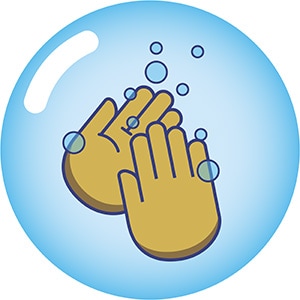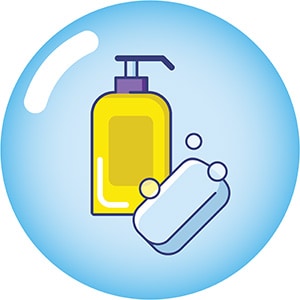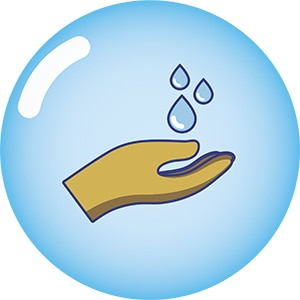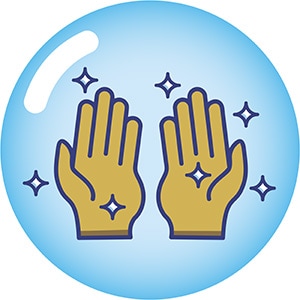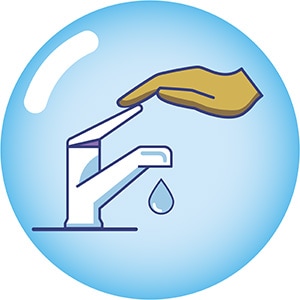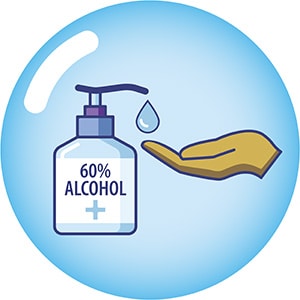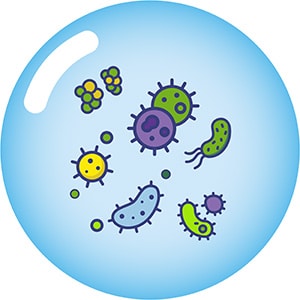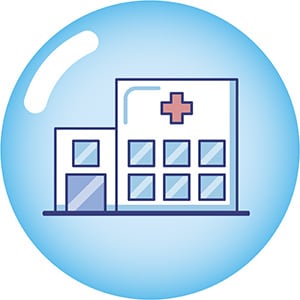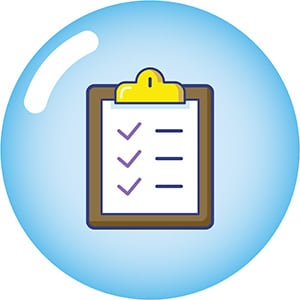Frequent Questions About Hand Hygiene
Handwashing is one of the best ways to protect yourself and your family from getting sick. Get answers to frequently asked questions about washing your hands and using hand sanitizer in community settings. For recommendations about hand hygiene for healthcare providers, visit CDC’s Hand Hygiene in Healthcare Settings website.
Do I really need to wash my hands for 20 seconds?
Scientific studies show that you need to scrub for 20 seconds to remove harmful germs and chemicals from your hands. If you wash for a shorter time, you will not remove as many germs. Make sure to scrub all areas of your hands, including your palms, backs of your hands, between your fingers, and under your fingernails.
How does handwashing with soap and water remove germs and chemicals?
Soap and water, worked into a lather, trap and remove germs and chemicals from hands. Wetting your hands with clean water before applying soap helps you get a better lather than applying soap to dry hands. A good lather forms pockets called micelles that trap and remove germs, harmful chemicals, and dirt from your hands.
Lathering with soap and scrubbing your hands for 20 seconds is important to this process because these actions physically destroy germs and remove germs and chemicals from your skin. When you rinse your hands, you wash the germs and chemicals down the drain.
Should I use a paper towel to turn off the faucet after washing my hands?
CDC recommends turning off the faucet after wetting your hands to reduce water use. Then, turn it on again after you have washed them for 20 seconds, to rinse off the soap. If you are concerned about getting germs on your hands after you wash them, you can use a paper towel, your elbow, or another hands-free way to turn off the faucet.
Use plain soap in either bar or liquid form to wash your hands.
Is antibacterial soap better than plain soap?
Use plain soap and water to wash your hands. Studies have not found any added health benefit from using antibacterial soap, other than for professionals in healthcare settings. In 2016, FDA banned over-the-counter sale of antibacterial soaps that contain certain ingredients because these soaps are no better than plain soap at preventing people from getting sick and their ingredients may not be safe for long-term, daily use. Some studies have shown that using antibacterial soap may contribute to antibiotic resistance.
Is bar soap better than liquid soap?
Both bar and liquid soap work well to remove germs. Use plain soap in either bar or liquid form to wash your hands.
Use clean, running water to wash your hands.
What if I have water but no soap to wash my hands?
If you don’t have soap and water, use a hand sanitizer with at least 60% alcohol. If you don’t have hand sanitizer or soap, but do have water, rub your hands together under the water and dry them with a clean towel or air dry. Rubbing your hands under water will rinse some germs from your hands, even though it’s not as effective as washing with soap.
Is it better to use warm water or cold water?
Use your preferred water temperature – cold or warm – to wash your hands. Warm and cold water remove the same number of germs from your hands. The water helps create soap lather that removes germs from your skin when you wash your hands. Water itself does not usually kill germs; to kill germs, water would need to be hot enough to scald your hands.
What if the water is dirty or contaminated?
Your hands can get germs on them if you place them in water that looks dirty, is contaminated (for example, during an emergency), or has germs in it from previous use, such as a basin with water used for bathing. That’s why CDC recommends using clean, running water to wash your hands. If you don’t have access to clean, running water, use hand sanitizer containing at least 60% alcohol to get rid of germs.
If you don’t have clean, running water or hand sanitizer, you can still remove germs from your hands by washing with clear water. You can also make water safe to use by boiling, adding the proper amount of disinfectant such as a mild bleach solution, or filtering it. Use the cleanest water possible to wash your hands. Avoid using cloudy water or water that may be contaminated with harmful chemicals or toxins, such as toxins made by harmful algal blooms.
If my utility has issued a Boil Water Advisory, can I still use tap water to wash my hands?
In most cases, it is safe to wash your hands with soap and tap water during a Boil Water Advisory. Follow the guidance from your local public health officials or water utility. If soap and water are not available, use an alcohol-based hand sanitizer containing at least 60% alcohol.
Use a clean towel or air dry your hands after washing them.
Should I dry my hands using a paper towel or an air dryer?
There is currently not enough scientific evidence to determine if using a clean towel or an air hand dryer to dry your hands is more effective at reducing germs on your hands. Both are effective ways to dry your hands. Germs spread more easily when hands are wet, so make sure to dry your hands completely, whatever method you use.
Should I reuse a towel to dry my hands at home?
CDC recommends using a clean towel if you are using a towel to dry your hands. Reusable towels are a practical option at home. They should be changed when visibly dirty and before they develop mildew from remaining damp.
Will touching bathroom door handles make my hands dirty again after I wash them?
Scientists don’t know if you would get a significant number of germs on your hands from touching a bathroom door handle. That’s because it has not been specifically studied. If you’re concerned about getting germs on your hands after you wash them, you can use a paper towel, your elbow, shirt, or another hands-free way to open the door.
Should I wash my hands after using the bathroom at home?
CDC recommends always washing your hands after you use the toilet, whether it is in your home or somewhere else. Germs in feces (poop) can make you sick. These germs can get on your hands after you use the toilet or change a diaper. If you don’t wash them off, you can pass them from person to person and make people sick. Make a habit of washing your hands after you use the toilet every time to reduce your chance of getting sick and spreading germs.
You can help yourself and your loved ones stay healthy by washing your hands often, especially during key times when you are likely to be exposed to, and spread, germs.
What are the key times to wash hands?
These are CDC’s key times you should wash your hands:
- Before, during, and after preparing food
- Before eating
- Before and after caring for someone at home who is sick with vomiting or diarrhea
- Before and after treating a cut or wound
- After using the toilet
- After changing diapers or cleaning up a child who has used the toilet
- After touching an animal, animal feed, or animal waste
- After handling pet food or pet treats
- After touching garbage
- If your hands are visibly dirty or greasy
After blowing your nose, coughing, or sneezing, you should immediately clean your hands by either washing them with soap and water or using hand sanitizer with at least 60% alcohol.
Find more information about when and how to use hand sanitizer.
Soap and water remove certain germs that hand sanitizers don’t kill, including germs that cause diarrhea such as norovirus, Cryptosporidium, and Clostridioides difficile.
Soap and water also remove harmful chemicals like pesticides and heavy metals.
Which is better, hand sanitizer or handwashing?
Washing hands with soap and water is the best way to remove all types of germs and chemicals. If soap and water are not available, use an alcohol-based hand sanitizer with at least 60% alcohol.
See CDC’s recommendations on when to use hand sanitizers and when to wash your hands.
How do hand sanitizers work differently than handwashing?
Alcohol-based hand sanitizers work by killing germs on your hands, while washing your hands with soap and water removes germs from your hands. Handwashing will remove all types of germs from your hands, but hand sanitizers are not able to kill all types of germs or remove harmful chemicals like pesticides and heavy metals.
Do wipes remove germs?
Hand sanitizing wipes with at least 60% alcohol kill germs on your hands.
Baby wipes are not designed to remove germs from your hands, and CDC does not recommend using them to clean your hands. They may make your hands look clean, but baby wipes and similar products that do not have at least 60% alcohol do not reliably remove germs from your hands.
Disinfecting wipes are designed to kill germs on surfaces. Do not use disinfecting wipes to clean your skin because they may cause irritation. Always read and follow the directions on the label to use these products safely.
What if I have a hand sanitizer that has no alcohol?
Hand sanitizers with at least 60% alcohol have been shown to be effective against a wider range of germs than hand sanitizers that do not contain alcohol, including those that contain active ingredients such as benzalkonium chloride (BZK). CDC recommends the use of alcohol-based hand sanitizers when soap and water are not available for handwashing.
What is the difference between CDC guidelines and FDA regulations for hand sanitizer use?
Hand sanitizer is regulated as an over-the-counter drug by the Food and Drug Administration (FDA). FDA regulates the production and manufacture of hand sanitizing products and determines which ingredients are allowed to be used in them. The Centers for Disease Control and Prevention (CDC) develops recommendations about hand hygiene to prevent the spread of diseases in both community and healthcare settings, based on peer-reviewed data and scientific studies.
Should I make my own hand sanitizer?
CDC does not regulate hand sanitizer production. However, CDC does not recommend producing, using, or selling homemade hand sanitizer products because of concerns over the correct use of the ingredients and the need to work under sterile conditions to make the product. Handwashing with soap and water is the best way to get rid of germs in most situations.
FDA reports that if made incorrectly, hand sanitizer can be ineffective or harmful. There have been accounts of skin burns from homemade hand sanitizers and serious health problems caused by hand sanitizers contaminated with methanol . To be effective at killing some types of germs, hand sanitizers need to have a strength of at least 60% alcohol and be used when hands are not visibly dirty or greasy. Do not rely on “do-it-yourself” (or “DIY”) hand sanitizer recipes based solely on essential oils or formulated without correct compounding practices.
Find more information about hand sanitizers and COVID-19 on the Food and Drug Administration’s FAQ page.
How does hand hygiene fight antibiotic resistance?
Hand hygiene helps stop the spread of germs, including ones that can cause antibiotic-resistant infections. Antibiotic resistance happens when germs like bacteria and fungi develop the ability to defeat the drugs designed to kill them. That means the germs are not killed and continue to grow. Infections caused by antibiotic-resistant germs are difficult, and sometimes impossible, to treat. Keeping your hands clean by washing your hands with soap and water or using alcohol-based hand sanitizer is one of the best ways to prevent germs from spreading and avoid infections.
Do hand sanitizers contribute to antibiotic resistance?
Alcohol-based hand sanitizers do not contribute to antibiotic resistance. Alcohol-based hand sanitizers kill germs, including antibiotic-resistant germs, by destroying the proteins and breaking down the protective outer membrane that germs need to survive.
Does washing hands with soap and water contribute to antibiotic resistance?
Plain soap (soap without antibacterial ingredients) does not contribute to antibiotic resistance. Some studies have shown that using antibacterial soap may contribute to antibiotic resistance. In fact, FDA banned over-the-counter sale of antibacterial soaps that contain certain ingredients because these soaps are no better than plain soap at preventing people from getting sick, and their ingredients may not be safe for long-term, daily use. Washing your hands with plain soap and water removes germs, including antibiotic-resistant germs. Keeping your hands clean can prevent the spread of germs, reducing the risk for antibiotic-resistant infections.
What method of hand hygiene is recommended for healthcare workers?
CDC recommends the use of alcohol-based hand sanitizers as the primary method for hand hygiene in most healthcare situations. Alcohol-based hand sanitizers effectively reduce the number of germs that may be on the hands of healthcare workers. Healthcare personnel often clean their hands more than 7 times in an hour. Some germs can be difficult to remove with soap and water and scrubbing can damage their skin. Healthcare personnel should wash their hands for at least 20 seconds with soap and water when hands are visibly dirty, before eating, after using the restroom, and after caring for people with infectious diarrhea during outbreaks. For more information, visit Hand Hygiene in Healthcare Settings.
Why are hand hygiene recommendations different in healthcare settings than in community settings?
Hand hygiene recommendations depend on the types of germs on your hands, whether your hands are visibly dirty or greasy, and where you are.
For healthcare settings, CDC recommends using alcohol-based hand sanitizer unless hands are visibly dirty.
In community settings, CDC recommends washing hands with soap and water because handwashing reduces the amounts of all types of germs and chemicals on your hands, including when hands are visibly dirty or greasy. If soap and water are not readily available, hand sanitizers with at least 60% alcohol can help protect you from getting sick from germs.
What supplies do I need for handwashing?
Ensure you have easily accessible sinks; clean, running water; soap; and a way to dry hands, such as paper towels or a hand dryer.
How can I encourage handwashing among my employees?
Remind employees to wash their hands often with soap and water and provide accessible sinks, soap, water, and a way to dry their hands (e.g., paper towels, hand dryer). Put visual reminders, like signs or posters, in bathrooms or kitchen areas to remind employees to wash their hands. Provide other hygiene supplies such as tissues, no-touch/foot pedal trash cans, and hand sanitizer with at least 60% alcohol to keep your employees healthy.
Does CDC regulate handwashing in community settings?
No. CDC is not a regulatory agency, and therefore does not enforce compliance with handwashing recommendations. CDC has developed guidance on when and how to properly wash hands in community settings and when and how to clean hands in healthcare settings.
Your state or local health department may have handwashing requirements included in their health codes.
